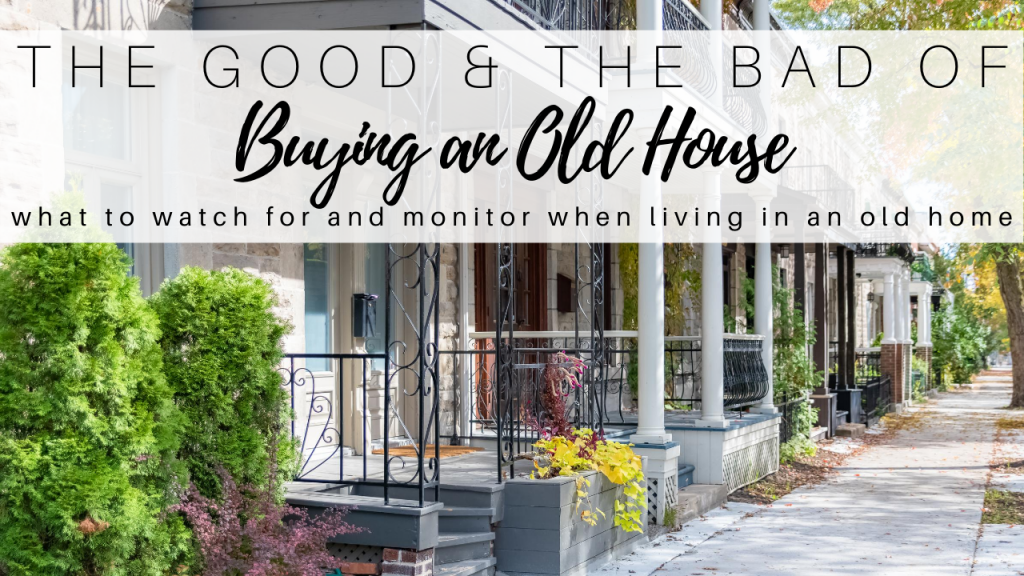
Do you ever notice in movies or TV shows where someone lives in an old house it always looks shiny and new somehow? While yes, that does happen outside of Hollywood, most old homes have lots of strange nuances with them and lots of areas that have gone without updating.
One of the BIGGEST mistakes I see buyers make when they fall in love with an old house is looking at the aesthetics (because these old homes are BEAUTIFUL) instead of looking at the facts of the house.
They jump into buying a home that isn’t necessarily healthy, turning a blind eye to some of the toxic traits an inspector could help them find.
This makes sense though. House hunting is a whirlwind in and of itself filled with emotions of envisioning yourself in a new spot, the feeling you get when you’re inside your house, not to mention you have to make your decision quickly.
But what if we all went about buying an old house (or new house for that matter) with more logic and more fact based information? Of course every house has good qualities and some not-so-goood qualities. Being able to weigh these facts out is going to put you in the best spot possible when you decide whether or not to purchase a home.
Just know that every house has areas you can fix and change, you just have to be aware of what those are and how much time, resources and money they’ll cost you in the long run.
It’s pretty rare to find an old house that is a total tear down – in my opinion they can almost always be salvaged. But you have to know what’s going on underneath all the aesthetics to make your decisions based on facts.
As a home inspector, one of my favorite parts of my job is walking through a beautiful, old house. But I also like to dig in and show my buyers JUST what they might uncover. I also like showing them the benefits of living in an old house. This post will walk you through both the good and unhealthy things you may find in an old house.
THE GOOD THINGS ABOUT BUYING AN OLD HOUSE
There’s more good about buying an old house or owning an old house than just the adorable charm and character that often comes with the unique floorplan, original woodwork and ornate details. I:n fact there are some really great features and qualities that often go along with an older home that make it a healthier environment than some of the more recently built homes.
More AirFlow: Generally speaking, an older home has more spots for air to escape and filter in naturally. This air flow idea is referred to as an air exchange. An air exchange is basically the idea that the indoor air is escaping your home and fresh, outdoor air is coming in to replace it. Once the air in your house has been completely replaced by the fresh outdoor air, you’ve got one full air exchange.
Many older homes have somewhere between 1 and 5 air exchanges per hour. A newer home generally has 1 air exchange every three hours. The reason this fresh air is so important to the health of our homes is because of the toxins we have inside our homes. Those VOCs and toxins can build up within our air, however with frequent air exchanges, the potency and concentration of these toxins is much less. This post will walk you through some very simple ways to improve the indoor air quality in your old or new home.
Fewer Synthetic Materials: Again, as a general assumption, older homes have less things like laminate flooring and carpet. If you’ve read my post on toxins in carpets, you know that older carpet in homes can house many toxins and ruin the indoor air quality within your home. Oftentimes, older homes have original hardwood flooring and natural tile within the home, which contain fewer toxins than carpet and vinyl flooring. (I’ll give you a disclaimer that this is not always true, however, depending on what era the home was updated in).
New homes are built with a lot of synthetic products like laminate, plywood and manufactured wood. These products are often installed with harsh adhesives and solvents that contain formaldehyde and other VOCs. When you’re buying an old house, be sure to look for things like original wood planking underneath the floors and in attic spaces to ensure that there is less plywood and formaldehyde in the home.
Higher Quality Finishes: Typically in older homes all natural wood is used rather than medium density fiberboard, vinyl and composites containing plastic and toxins. Wood is often the best material when it comes to avoiding toxins. However, you must also be wary of the stain and clear coat that are applied to the wood, but this can be changed without removing the wood itself oftentimes.
Natural ceramic tile is also another low and no toxin finish that older homes have. It’s much better than having vinyl or synthetic linoleum, which some homes have been updated with. Finding a home with solid wood cabinets, doors, flooring and trim can be a great way to ensure little adhesive, cheap additives or other chemicals are being used.
Reusing Instead of Building New: While this doesn’t necessarily play into the the health of your home, when you’re buying an old house, you’re essentially reusing what’s there instead of building something new and creating additional waste in our community and environment.
One of the principles behind creating a healthy house is using fewer brand new items and creating an indoor space that is healthy using natural items that are already in the world. This is the exact principle that comes into play when buying an old house.

THE DANGEROUS TOXINS OF BUYING AN OLD HOUSE
Not everything in an old house is rainbows, however. Because an older home has often had several owners, materials may have been updated during different eras. Some of the eras in a home’s past could include using extremely toxic materials like lead, asbestos and plastic in the wrong applications.
It’s important to know how to identify these dangerous toxins when you’re buying an old house as well as if you currently own an old house.
Asbestos: Asbestos is a cancer causing material (ASBESTOS STUDY) that can be present in many different areas of an old house. Asbestos exposure has been linked to lung cancer and abdominal cancer as well as mesothelioma (ASBESTOS RESEARCH).
Asbestos becomes airborne as tiny particles and dust and is often inhaled into the lungs. This is why oftentimes, if asbestos is not disturbed, it poses less of a risk to humans. That being said, we have many habits in our lives that may be disturbing asbestos on a regular basis.
Asbestos can be present in attic insulation, flooring (check for 9×9 vinyl floor tiles in a old home, which likely contain asbestos), ceiling tiles, popcorn ceilings, and even drywall. If you’re buying an old house, obviously, get an inspection and make sure you ask your inspector if they can identify asbestos before you hire them. You can also get a simple kit from amazon to send a sample into a lab to have it tested for asbestos. You also have the option of contacting a special company that will inspect for just asbestos in your home.
Lead: Lead was widely used in paint and pipes in older homes. If you’re buying an old house built before 1978, there’s potential that you have some lead paint in the home. Now, lead paint, undisturbed and free of chips is no problem at all. Once it starts to chip, the dust can become an issue with members of the home inhaling the particles.
Lead exposure is a problem in terms of health, especially in children, where it can build up to poisoning levels and affect learning and behavior. (LEAD EXPOSURE STUDY).
Lead pipes can also be present, however, most often it’s only in drain pipes within the home. A simple scratch test can help you identify if you have lead pipes. Lead pipes are dull and gray in color. When scratched with a key or fingernail, an indent will be left that is often shinier in appearance.
When buying an old house, an inspector who can identify lead in a home (either in paint or pipes) will be a huge asset. If you own an older home, you can purchase a rapid test with a swab to help you identify parts of your home that have lead within them.
Formaldehyde: Formaldehyde is a known carcinogen and is found in many applications throughout both new and old homes. This post I did has information about formaldehyde and where to look for it in your home. Essentially any place in your home where adhesives are used (think cabinets, countertops, flooring, etc), there’s a potential for formaldehyde to be present. This is why it’s important to know what type of finishes are in your holder home. If you’re buying an old house, make sure you know what decade it was updated in, or assess any upgrades that have been made to vinyl or laminate.
Formaldehyde never stops off-gassing, especially in older materials, where the concentrations are higher. FOrmaldehyde affects the respiratory system and can increase problems with asthma. It has also been linked to various kinds of cancer in high concentrations. (FORMALDEHYDE INFORMATION)
This indoor air quality monitor by Awair is a great addition to any home when you’re trying to assess if VOCs and formaldehyde are present.
Radon: While radon is not necessarily a problem only present in older homes, it CAN be more prevalent in older homes due to their foundations. Radon is an odorless carcinogen in the form of a gas that enters our homes through the soil beneath it. Homes that have more cracks and gaps in their foundation typically have higher levels of radon if it’s in the soil. Radon is everywhere outside, however when it enters the home, it becomes highly concentrated in lower levels.
When someone is exposed to high levels of radon it increases their risk of cancer, especially in children, those with lung tissue damage and smokers. This blog post I did talks about EVERYTHING you need to know regarding radon and your home.
I recommend EVERYONE gets a radon test whether buying an old house or a new house. If you’ve already purchased your home, getting either a one time test or a continuous radon monitor is a great idea to make sure you don’t have elevated levels of radon in your space.
Mold: Again, mold can be in ANY house, and sometimes newer homes have more present within the walls just because of building practices that were being used during the time the home was built. However, generally speaking, older homes have had more moisture intrusion and can have more humid environments due to poor air circulation, which contribute to mold growth.
Many old homes didn’t have fans in humid spaces like bathrooms and kitchens originally. This means that these spaces had periods of time where they probably didn’t dry out as well as they should have.
Basements in old homes can also have levels of high humidity due to the type of foundation block or stone used and the lack of drainage around the home. Check for levels of high moisture and do a visual inspection for mold when you’re buying an old house to make sure you’re avoiding potentially BIG problems.
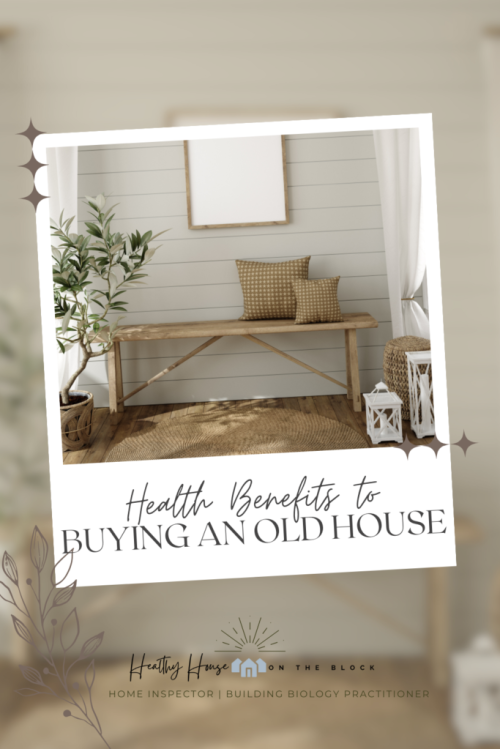
BEST TIP FOR BUYING AN OLD HOUSE:
I may be a little biased, but I truly feel the BEST way to give yourself a HUGE advantage when buying an old house (or any house for that matter) is to not only get a home inspection, but also attend the whole inspection.
So many people come at the end of the inspection for a recap. I’m telling you, if you’re there for the entire inspection, you’ll be able to ask SO many more questions and get a better idea of the space as the inspector works.
These two resources below will not only help you hire the RIGHT home inspector, but give you an idea of items to look for and ask about DURING the home inspection process:
You should also consider additional services that aren’t included with a typical home inspection. These are inspection services that will shed light on bigger problems or test for toxins you can’t always see with your eyes:
- Sewer Scope (many old homes have old sewer lines out to the street. These can become damaged by tree roots and normal wear and can be quite costly to repair).
- Radon Testing (if you have higher levels of radon in your state, this is a MUST to ensure your home is safe and has minimal levels of this carcinogenic gas).
- Mold Testing (if you find areas of visible mold or mildew, it may be a good idea to have an air test or swab test done of the area to see just how toxic the mold is and if there are high counts of mold in the air).
- Asbestos Testing (if your inspector finds insulation, flooring or ceiling tiles that likely contain asbestos, you can have those items tested by a lab to see what percentage of asbestos they contain).
- Lead Testing (if your home was built before 1978, there’s likely lead somewhere in old layers of paint. If the paint is chipping and peeling, you can have your inspector take a sample to find out if the paint contains lead or not. They can also use wipes to take a sample any area you have concerns about).
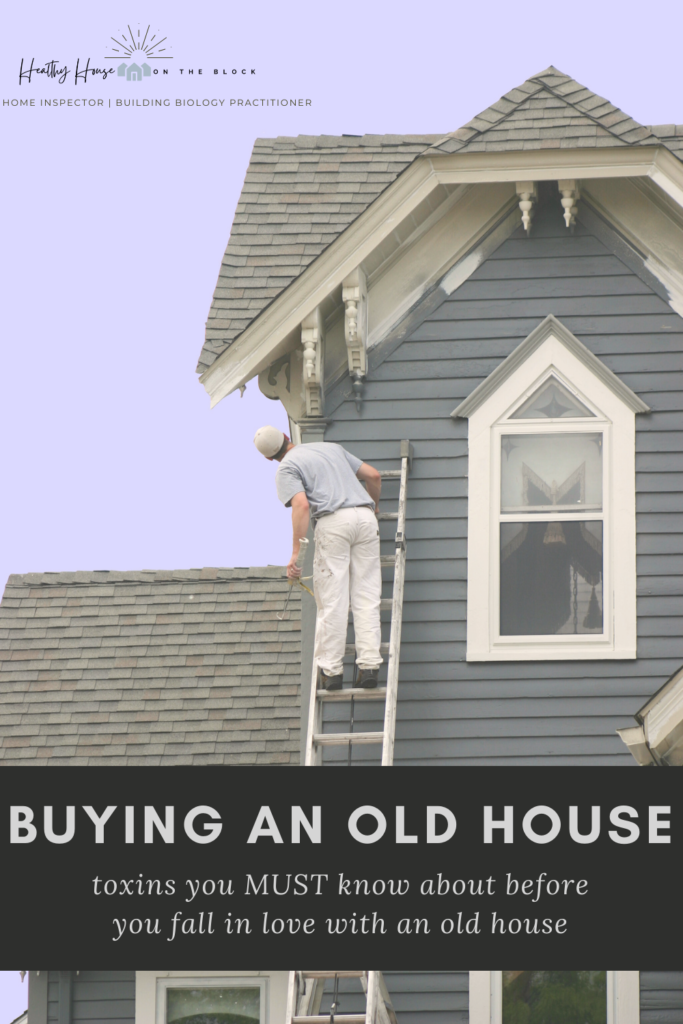
There are SO many positives about buying an old house. Just make sure you go into the process knowing all the facts and don’t get too swayed by the beauty of an old house. Use fact based information to make your decision and you won’t be left with a toxic house.
Share this:
- Click to share on Facebook (Opens in new window) Facebook
- Click to share on LinkedIn (Opens in new window) LinkedIn
- Click to share on Reddit (Opens in new window) Reddit
- Click to share on Pinterest (Opens in new window) Pinterest
- Click to print (Opens in new window) Print
- Click to share on X (Opens in new window) X

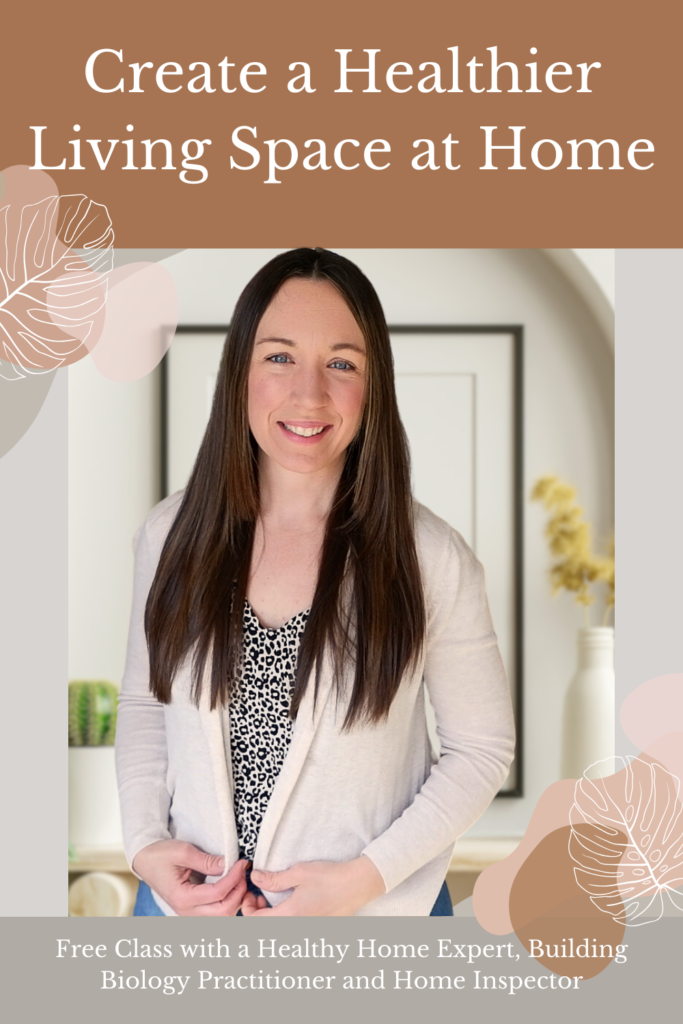


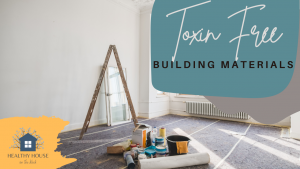


Some old homes have PCBs also; it’s just recently being researched in residential homes. They can be in the floor finishes in homes built Prior to 1978.